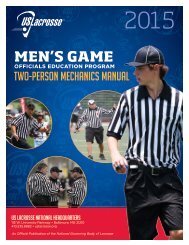BASKETBALL
Create successful ePaper yourself
Turn your PDF publications into a flip-book with our unique Google optimized e-Paper software.
Rule 1 / Court and Equipment23<br />
Section 12. Backboards—Support Systems<br />
Art. 1. Padding—Any backboard support behind a backboard and at a height of<br />
less than 9 feet above the floor shall be padded on the bottom surface to a distance<br />
of 2 feet from the face of the backboard. All portable backstops shall have the<br />
bases padded to a height of 7 feet on the courtside surface.<br />
Art. 2. Protrusions and Clearances<br />
a. Protrusions below backboards shall not be allowed.<br />
b. Any backboard support, all of which is not directly behind the backboard,<br />
shall be at least 6 inches behind the backboard when the support extends<br />
above the top and at least 2 feet behind the backboard when the support<br />
extends beyond the side.<br />
c. Any support system below or behind a backboard shall be at least 8 feet<br />
behind the plane of the backboard face and a height of 7 feet or more<br />
above the floor.<br />
d. Any overhead backboard support structure that must be forward-braced<br />
because of space limitations, architectural or structural restraints, shall<br />
meet the following requirements: A front diagonal brace support system<br />
must be located above a line extending upward and into the playing court<br />
at a maximum 45-degree angle from a point on a vertical line located<br />
a minimum of 6 inches behind the front surface of the backboard at a<br />
minimum height of 4 feet 6 inches above the basket ring.<br />
Section 13. Backboards—Positions<br />
Art. 1. Each backboard shall be positioned midway between each sideline, with<br />
the plane of its front face perpendicular to the floor, parallel to and 4 feet from<br />
each end line.<br />
Art. 2. The upper edge of each backboard shall be 13 feet above the floor.<br />
Art. 3. Each backboard shall be protected from spectators to a distance of at least<br />
3 feet from the end of each backboard.<br />
Art. 4. Portable backboards shall be secured to the floor to prevent movement.<br />
Art. 5. Neon, electric, LED or artificially lit signage shall be permitted on the<br />
horizontal stanchion booms; however, it shall not be permitted on the vertical<br />
backboard stanchion arms. The permitted signage must conform to the following:<br />
a. Signage must be static when the ball is live;<br />
b. Maximum Physical Area (H x W x D) 14” x 52” x 2”;<br />
c. Maximum Active Display Area (H x W) 12” x 46”;<br />
d. No hard metal or material on the underside or sides of the unit can be<br />
exposed. The signage unit must be padded with rounded edges, including<br />
across the bottom of the unit. A minimum of .75-inch thick padding must<br />
be provided. All padding must be the same color(s) as the stanchion arm;<br />
e. The front of the sign must be located a minimum of 6 feet behind the<br />
baseline, and the bottom cannot extend lower than 6 inches from the top of<br />
the horizontal stanchion boom arm;<br />
f. The sign must be installed with a Safety Plex covering in all cases; and<br />
g. A maximum of two panels are permitted per arm (one per side) and must<br />
face to the side or behind the playing court.




